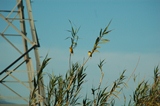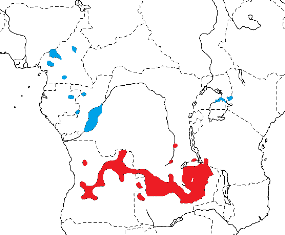Weaver species
Choose different species from drop-down list and press 'Go' button. See Full species list.Marsh Widowbird Euplectes hartlaubi
IUCN: Least concern Discovery: 075Categories: long tail, fruit,
News items about species
Discovery
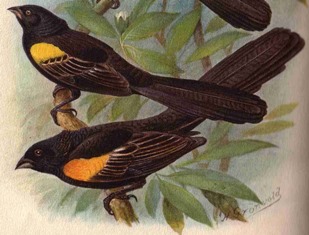
figure from Delacour (1933) 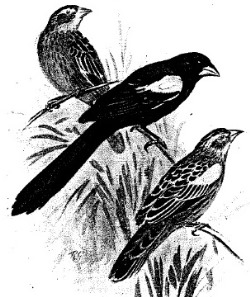
non breeding male, figure from Bannerman (1949) 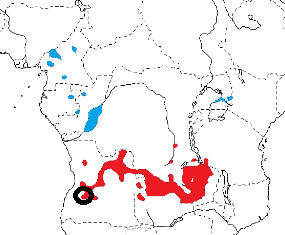
distribution, type locality circled IntroductionThe Marsh Widowbird was formally described by Jose Vicente Barbosa du Bocage, a Portuguese zoologist and politician. He was curator of the Lisbon Museum, and described several other weavers.The Marsh Widowbird was collected by Jose Alberto de Oliveira Anchieta, a Portuguese explorer and naturalist, who collected a large number of birds in Angola. In 1867 the Portuguese government hired Anchieta as a naturalist but probably also as a secret agent and informer in the Caconda region of Angola. Anchieta lived in Caconda, explored the area and sent many specimens and letters to his scientific correspondents in Lisbon. Anchieta discovered the Marsh Widowbird near Caconda, and sent a single male specimen to the Lisbon Museum. Bocage measured the tail as 160 mm, while tail length in the nominate subspecies is usually 163-201 mm. The first illustration of the Marsh Widowbird was published in Delacour (1933). The second illustration was published by Bannerman (1949), as a black and white sketch, but also showing the female and non-breeding male. Scientific citationPenthetria hartlaubi Bocage 1878 Jorn. Sci. Math. Phys. Nat. Lisboa, 6, p.259 Caconda, Angola.Meaning of nameshartlaubi, After Karl Johann Gustav Hartlaub (1814-1900) German ornithologist and author.First English nameHartlaub's Widow Bird (Layard 1884).Alternate namesHartlaub's Marsh Whydah, Hartlaub's Marsh Widowbird, Marsh Whydah, Uganda Marsh Whydah.CollectorJose de Anchieta.Date collectedBefore 1878.Locality collectedCaconda, Angola.Type specimensThe type specimen was in the Museum of Lisbon, before a fire destroyed the museum. |
The above is based on Weaver Wednesday 2, a weekly series about the discovery of each weaver species.
This species text first appeared as
Weaver Wednesday [192] - Discovery [75]: Marsh Widowbird on 2016-02-17
1. Basic biology
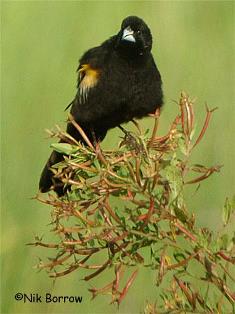
photographer Nik Borrow 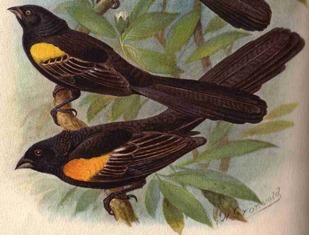
from Delacour 1933, and Yellow-mantled Widowbird (above) with black mantle in E Africa In Kenya the similar Yellow-mantled Widowbird has yellow epaulets while these are orange in the Marsh Widowbird, and further south the Yellow-mantled Widowbird is distinguished by a yellow mantle. The non-breeding male Marsh Widowbird is dull with coloured epaulets and dark wings. The female is dull with a dusky underwing and buff underparts. Distribution.
Two subspecies of the Marsh Widowbird are recognised (see map below, based on Birds of Africa):
Habitat. The Marsh Widowbird inhabits swampy grasslands and nearby cultivated areas. It may visit deeper water in reeds, perching on floating lily leaves or other floating vegetation. Food. The Marsh Widowbird feeds on grass seeds, insects including grasshoppers and small fruit and berries. It usually forages in small groups, often with other widowbirds. Breeding. The Marsh Widowbird is polygynous. The nest is spherical, with a side entrance. The male builds the outer frame of the nest, using fine grass stems and incorporating living grass, which forms a bower over the nest. The female adds lining of dry grass, and continues to add lining after the first eggs have been laid. The nest is placed low down, usually within 20 cm of the ground, in wet areas with dense grass. The clutch is 1-3 eggs, which are pale greenish-blue or olive-green, marked with spots and blotches. There is no other information on breeding. |
The above is based on Weaver Wednesday, a weekly series about weaver species.
This species text first appeared as
Weaver Wednesday [106]: Marsh Widowbird on 2014-06-25
2. Breeding facts
| Pair bond Polygynous Breeding season May in Uganda, Dec-Feb in Angola, Jan-Mar in S DRCongo and Dec-Feb in Zambia Nest site sited low dowm (usually within 20 cm of ground) in wet areas with dense grass c. 0.5 m tall Nest building frame constructed by male, female adds lining Colony size No information Clutch size 1-3 eggs (mean 2 in DRCongo) Egg colour nominate race: pale greenish-blue with olive-grey spots and blotches, and some chocolate-brown spots at thicker end; race humeralis: pale olive-green with irregular brown blotches and darker squiggles Egg size average size of 16 eggs 22 x 15.4 mm (S DRCongo) Incubation No information Chicks and nestling period No information |
Breeding information based on Handbook of the Birds of the World, Vol. 15.
3. Photos of Weaver Nests
No records yet - be the first to submit a PHOWN record!See PHOWN summary page for this species here.
PHOWN (Photos of Weaver Nests) provides valuable info on breeding distribution and colony sizes of weavers.
You can contribute by registering and submitting photos at Virtual Museum webpage.
4. Breeding distribution
Google map showing distribution (For species with small ranges you need to zoom in at the correct area to see the range):
yellow blob - range of weaver species; read more about this here.
![]() - PHOWN records with photos
- PHOWN records with photos
![]() - PHOWN records with no photos (Nest Record Cards, other records)
- PHOWN records with no photos (Nest Record Cards, other records)
![]() - Birdpix records
- Birdpix records
![]() - comments on out of range records, or interesting records
- comments on out of range records, or interesting records
![]() - type locality
- type locality
CLICK on the marker on the map to see individual record details.
5. Range changes
Not South African speciesThe above is based on Weaver Wednesday 3, a weekly series about range changes in South African weaver species.
This species text first appeared as
n/a








